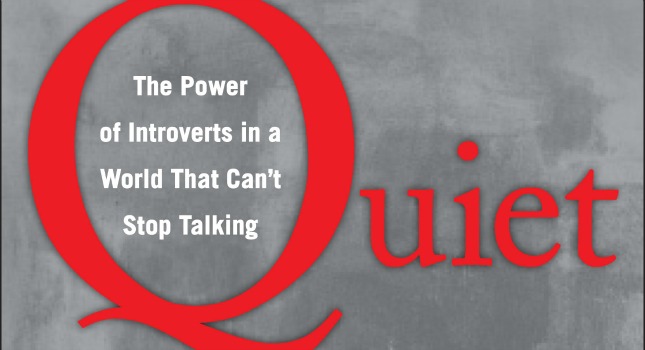In order to prevent us nice Christian teenagers from indulging in let-loose drinking and debauchery on graduation night, a group of parents devised a nefarious plan: an all-night party at an undisclosed location. My graduating class in 1983 was among the first at my high school to be subjected to this torture. For me, the ideal celebration would have been to go home after the ceremony, lock myself in my room, and listen to classical music. But no. Everyone had to come. So I was compelled to go to this awful party, lose a night of sleep, and pretend to have a fantastic time playing games and turning in raffle tickets for donated prizes.
At the time, I felt an uncomfortable mix of indignation and guilt: why are they doing this to me? mixed with why am I such a party pooper? If only I had been armed with Susan Cain’s recent book: Quiet: The Power of Introverts in a World That Can’t Stop Talking (Crown 2012). I would have affirmed my own style, united the fellow introverts in my class, and staged a quiet resistance to the “extrovert ideal.”
Quiet is one of those rare epiphany books that opens up a whole layer of insight, causing exhilaration in the newly enlightened reader—and exasperation among all the reader’s family and friends. Remember the first time you took the Meyers-Briggs, and the whole world suddenly made sense through the little sixteen-square grid, and you asked everyone their type and responded with a smug I thought so because now you could spot an ENFP a mile away? Yes, well, Cain has provided a similar service, this time with special attention to the I side of that extrovert/introvert divide.
Cain is a Harvard-trained lawyer who built a successful career, deeply relishing some parts of her job—the study and analysis and writing—while finding other parts horribly difficult—the conflict, the public speaking. She realized, however, that her “weaknesses” made her especially skilled at negotiation. Puzzled by this paradox, she started studying introversion and extroversion, chasing down research in psychology, business, child development, creativity, and a whole assortment of topics with fascinatingly hidden connections. Quiet is the resulting gentle manifesto: a celebration of introversion and a call to shape our society for the better flourishing of everyone’s gifts.
Epiphany books often operate by gathering things we already know or suspect and analyzing their connections. I knew even back in high school that, although I liked people, I also enjoyed being alone and needed time alone to recharge. That’s a simple definition of introversion. But Cain explains a number of other qualities that tend to characterize introverts: sensitivity to noise and overstimulation, aversion to conflict, hatred of small talk, few close friends rather than many casual friends. In the chapter on temperament, Cain recounts the work of Harvard psychologist Jerome Kagan, whose longitudinal studies have demonstrated that high sensitivity to the environment is an in-born trait, and that “high-reactive” infants reliably grow up to be introverted. Why? Because, in order to cope with their high sensitivity to the environment, they find ways to limit the amount of stimulation they receive. Meanwhile, “low-reactive” infants can comfortably tolerate more input, and typically grow up to be extroverts.
I used to think of my own high-sensitivity and conflict aversion and hatred of small talk as disadvantages or even faults. I have learned how to fake extroversion, how to “pass” as outgoing and sociable. But here is one of Quiet’s most important insights. Cain insists—quietly and persistently, in true introvert style—that these “problem” traits are only the flip side of strengths. Introverts tend to experience them as disadvantages or faults because we live in a culture that has thoroughly adopted the “extrovert ideal.”
The first chapter of the book elegantly narrates the shift in American society, around the early 1900s, from the “Culture of Character” to the “Culture of Personality.” The move from rural to urban life, an economy based increasingly on business and sales, Dale Carnegie and the rise of Madison Avenue—all of this combined to idealize the outgoing people-person and disadvantage the quieter person to the point, in some cases, of pathologizing and attempting to “cure” shy kids. Cain examines an intriguing spread of artifacts—advertisements and bestselling books and university admissions documents—to support the assertion that by mid-century, education and business were almost entirely geared to creating gregarious, sociable people who work well in groups. Meanwhile, as Cain explains in another chapter, other cultures—the Chinese and Japanese, for example—honor the introvert, attributing silence to wisdom and quiet demeanor to honor for relationship.
This historical and cross-cultural analysis unmasks the myriad (and infuriating!) ways in which American culture is set up to suit extroverts. Work teams and open-office cubicles, classrooms that “facilitate group learning,” and the “myth of charismatic leadership” all serve to frustrate and suppress the gifts that introverts offer. Cain then proceeds to disassemble the unconscious assumptions upon which this system is based: as it turns out, the idea that extroversion is always better simply does not hold up.
With a backdrop of gracefully assembled research, Cain explains that actually, the most successful business and military leaders are often introverts. Actually, in-person collaboration does not consistently produce the best or most creative or most effective results. Actually, the most innovative people spend their most productive hours working alone. Her chilling analysis of the 2008 financial crisis might be enough to convince anyone of the disadvantages of a strongly extrovert-skewed system.
For those of us familiar with the evangelical Christian world, Cain’s section on Saddleback Church proves especially challenging. Through narrating her visit to Saddleback in Lake Forest, California, she offers a smart and accurate account of how evangelical megachurches valorize the extrovert ideal—charismatic leaders, demonstratively emotional worship, and constant gatherings of people. She interviews a pastor who is trying to survive this world as an introvert and coping with his vague sense of failure. Though Cain is an outsider to evangelicalism, she describes empathetically how the evangelical style makes introverts feel like second-class citizens, evoking feelings of guilt and even divine disapproval.
Against that vague feeling of discomfort and disadvantage that introverts feel in many settings, Cain’s most important contribution in the book is her championing of the essential gifts that introverts bring to the table. Introverts tend to be more realistic about risk, think more deeply and creatively, have stalwart and unwavering moral commitments, and transcend groupthink. Charming accounts of remarkable introverts such as Rosa Parks, Eleanor Roosevelt, Warren Buffet, and Steve Wozniak give personal dimension to these claims.
I would have loved to slam the book shut after reading the last page and declare my vindication: Aha! Just as I’ve always suspected: introverts, though oppressed and disadvantaged, are the superior beings! Unite, oh introverts, and alter the world in our favor! But no, Cain is too carefully evenhanded to allow for that, her goal to celebrate the gifts and styles of both extroverts and introverts, to help us understand ourselves and each other and live and work together better. To that end, I appreciated the wisely chosen range of topics, from business and education practices to marriage and child-rearing advice. I’m planning to ask my wonderful extroverted husband to read the sixteen-page chapter on introvert-extrovert marriages. Cain’s account of “Emily” and “Greg” and their relationship could easily have described “Ron” and “Deb,” and Cain offers helpful advice about managing conflict so that both parties feel that their “style” is understood.
Cain wishes to help equip all of us to be our best selves. Everywhere she insists that our temperaments are only the raw material. Introverts, given a few thoughtful strategies, can learn to be great public speakers and enjoy parties, and extroverts can learn to work alone quietly and think carefully through problems. We can become balanced people, working with our strengths and even leveraging what feel like weaknesses.
I do wish everyone would read this book, especially those of us in business, education, and the ministry who have the power to recognize, affirm, and develop the styles and gifts of people in our care. I wish especially that my fellow introverts could share my experience of this book: a “newfound sense of entitlement to be yourself.”





